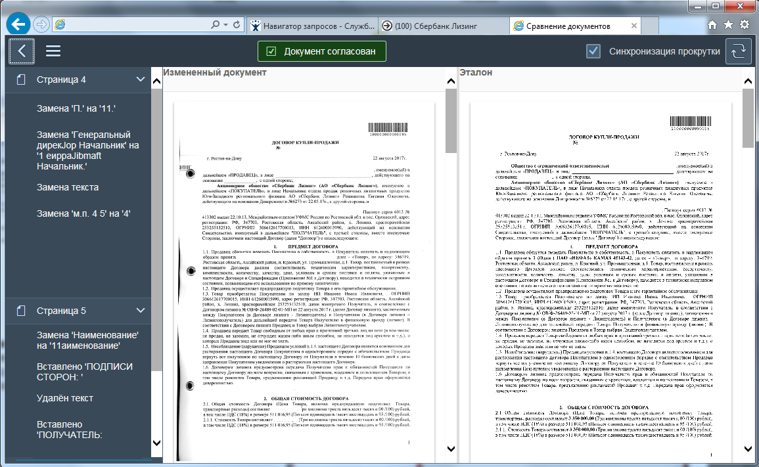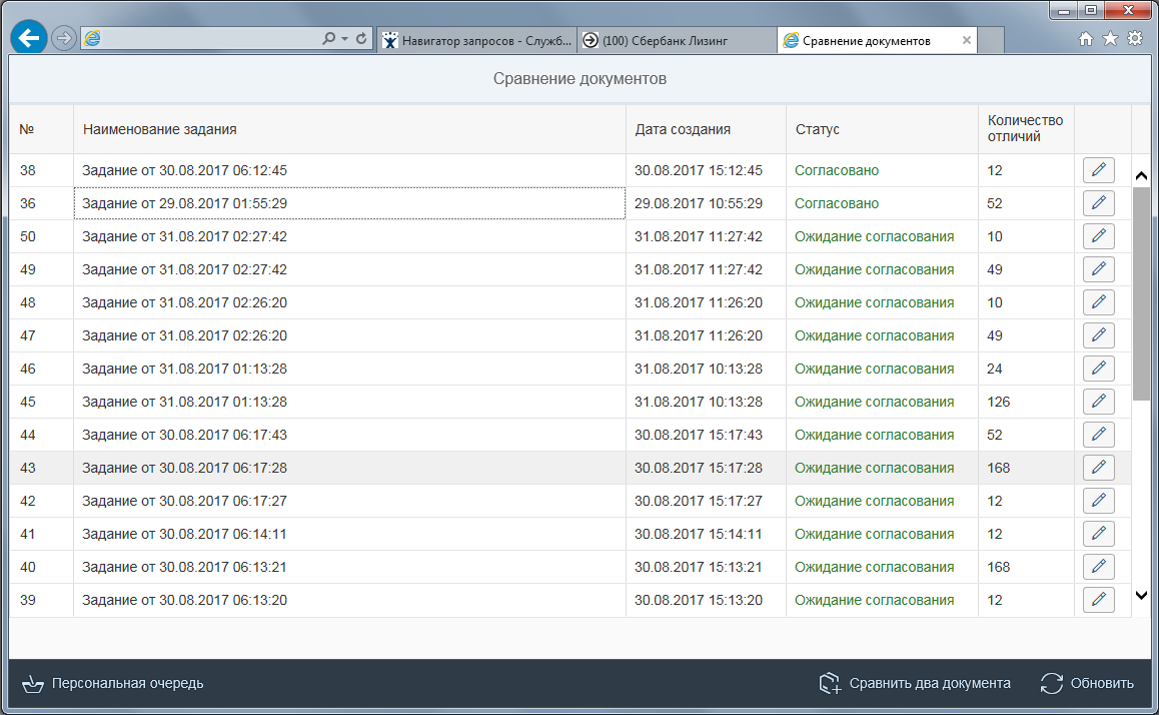Fifteen Useful Details for Electronic Document Management
Hello! In touch, experts "Sberbank Leasing." A huge part of our work is related to documents, therefore it is in our interest to constantly improve our COURT - document management system. Until recently, she was, frankly, not the best assistant and took a lot of time and effort. There was no single electronic repository, automated scanning and verification of documents, as well as control over the availability of originals in the archive.

There was no ready-made solution that could solve all three problems on the market, so we began work on our own project “Electronic DOC.ofis”. About what happened, we will tell in this post.
In short, our COURT is a personalized project in which several information systems are interconnected: Navision, IBM Filenet and ABBYY solution complex.
')
Navision is our key ERP system in which all processes are recorded: from the coordination of memos to the formation of internal documents. All employees of the company work in Navision - from the secretariat to the financial services. We develop and support Navision on our own, we have a large team of specialists.
IBM Filenet is our document repository where all electronic records are generated.

Project Dossier
ABBYY solution complex is designed for document recognition. It includes the data recognition subsystem and the information input subsystem (or scanning station). We have long been partnering with ABBYY, and, if we evaluate the market, it was the only sufficiently functional candidate who could cope with our requirements.
Here is a brief algorithm for the "Electronic DOC-office":
The general scheme of work is quite simple. But in order to make our system SUD easy to use, we had to improve all key work processes. We describe everything in order.
Quick card creation. Now it’s enough to enter an INN or OGRN in the card, and all other information is filled in automatically. This speeds up the work, helps to avoid the introduction of incorrect data and duplication of cards.

Lease agreement where automatic filling of fields is possible
Personal responsibility. Now each client in the system is assigned a manager who is responsible for the relevance of the data and documents. This helps to avoid confusion in the data and to receive timely information about counterparties.
Formation of customer and supplier dossier
Single dossier. A single dossier structure, available for general use, appeared uniform for each counterparty (customer, supplier, guarantor). Also, all downloaded documents are easy to identify and find in the electronic storage. No more chaos.
Reduction of paper workflow. Before the introduction of the new system, we spent large sums on shipping and storage of paper files. At the new stage, we abandoned part of the documents on paper in favor of scanned copies.

ABBYY scan window
Control of the validity of documents. Previously, we did not know exactly whether the documents we downloaded are relevant. Now, expired documents are highlighted in red.
Standards for quality scans and uniform format. ABBYY has requirements for the format and quality of scanned copies of documents.
Fast stitching documents. We have simplified the requirements for cross-linking contractual documentation, and the scanning process now takes not a quarter of an hour, but just three minutes. Loading documents in the dossier also happens much faster than before.
Formation of contractual documentation
Automation. Now employees need to make the minimum number of revisions to contracts and project cards, the system will do most of the work itself.
Easy navigation. An orderly structure, convenient for employees, appeared in the project documents.
Quick fill fields. The development of the Navision system and the refinement of the contractual documentation templates allowed us to reduce the time to fill in the fields after unloading the contract.
Automatic bar coding. The introduction of this function eliminated the “manual” verification of data. The system compares documents and generates test results in just three minutes.
Operational search and upload documents. If earlier there was a task to unload all contracts for a certain period, then it was necessary to unload each document manually. Now, thanks to the mass upload, the system does everything on its own.

Document Comparison Window
 Negotiation queue
Negotiation queue
View archived documents online. To get acquainted with the archival document, simply find it in the system. The electronic archive stores all project documents created from the start of the company until the launch of the project.
Fast document registration process. Here again the bar-coding system helps out; it is also taken into account in the paper archive.
Electronic inventory of documents. Instead of the usual inventory on paper, we introduced its electronic counterpart. You can interact with the archive staff about the documents through the Navision system. We also developed a register of signed contracts to control the provision of documentation to the archive.
We outlined a certain number of different improvements that work fine with us. We hope our ideas will help you to improve your own COURT system.
So far, we are tracking the emergence of new versions of the systems included in our COURT, and try to immediately implement them. We are also engaged in the integration of two major new systems in Filenet - in the near future, electronic storages will work not only with Navision, but also with other implemented systems.
We will be happy to answer your questions about document management systems and their improvement in the comments.

There was no ready-made solution that could solve all three problems on the market, so we began work on our own project “Electronic DOC.ofis”. About what happened, we will tell in this post.
What is our solution?
In short, our COURT is a personalized project in which several information systems are interconnected: Navision, IBM Filenet and ABBYY solution complex.
')
Navision is our key ERP system in which all processes are recorded: from the coordination of memos to the formation of internal documents. All employees of the company work in Navision - from the secretariat to the financial services. We develop and support Navision on our own, we have a large team of specialists.
IBM Filenet is our document repository where all electronic records are generated.

Project Dossier
ABBYY solution complex is designed for document recognition. It includes the data recognition subsystem and the information input subsystem (or scanning station). We have long been partnering with ABBYY, and, if we evaluate the market, it was the only sufficiently functional candidate who could cope with our requirements.
Here is a brief algorithm for the "Electronic DOC-office":
- Through ABBYY managers scan documents. There is a filling of their attribute composition.
- Documents and the completed attribute composition is stored in Filenet electronic storage.
- Documents and attribute composition is displayed in Navision.
The devil is in the details
The general scheme of work is quite simple. But in order to make our system SUD easy to use, we had to improve all key work processes. We describe everything in order.
Creation and filling of the counterparty card
Quick card creation. Now it’s enough to enter an INN or OGRN in the card, and all other information is filled in automatically. This speeds up the work, helps to avoid the introduction of incorrect data and duplication of cards.

Lease agreement where automatic filling of fields is possible
Personal responsibility. Now each client in the system is assigned a manager who is responsible for the relevance of the data and documents. This helps to avoid confusion in the data and to receive timely information about counterparties.
Formation of customer and supplier dossier
Single dossier. A single dossier structure, available for general use, appeared uniform for each counterparty (customer, supplier, guarantor). Also, all downloaded documents are easy to identify and find in the electronic storage. No more chaos.
Reduction of paper workflow. Before the introduction of the new system, we spent large sums on shipping and storage of paper files. At the new stage, we abandoned part of the documents on paper in favor of scanned copies.

ABBYY scan window
Control of the validity of documents. Previously, we did not know exactly whether the documents we downloaded are relevant. Now, expired documents are highlighted in red.
Document scanning
Standards for quality scans and uniform format. ABBYY has requirements for the format and quality of scanned copies of documents.
Fast stitching documents. We have simplified the requirements for cross-linking contractual documentation, and the scanning process now takes not a quarter of an hour, but just three minutes. Loading documents in the dossier also happens much faster than before.
Formation of contractual documentation
Automation. Now employees need to make the minimum number of revisions to contracts and project cards, the system will do most of the work itself.
Easy navigation. An orderly structure, convenient for employees, appeared in the project documents.
Quick fill fields. The development of the Navision system and the refinement of the contractual documentation templates allowed us to reduce the time to fill in the fields after unloading the contract.
Verification of signed documents
Automatic bar coding. The introduction of this function eliminated the “manual” verification of data. The system compares documents and generates test results in just three minutes.
Work with electronic archive of documents
Operational search and upload documents. If earlier there was a task to unload all contracts for a certain period, then it was necessary to unload each document manually. Now, thanks to the mass upload, the system does everything on its own.

Document Comparison Window
 Negotiation queue
Negotiation queueView archived documents online. To get acquainted with the archival document, simply find it in the system. The electronic archive stores all project documents created from the start of the company until the launch of the project.
Document storage in paper archive
Fast document registration process. Here again the bar-coding system helps out; it is also taken into account in the paper archive.
Electronic inventory of documents. Instead of the usual inventory on paper, we introduced its electronic counterpart. You can interact with the archive staff about the documents through the Navision system. We also developed a register of signed contracts to control the provision of documentation to the archive.
So what?
We outlined a certain number of different improvements that work fine with us. We hope our ideas will help you to improve your own COURT system.
So far, we are tracking the emergence of new versions of the systems included in our COURT, and try to immediately implement them. We are also engaged in the integration of two major new systems in Filenet - in the near future, electronic storages will work not only with Navision, but also with other implemented systems.
We will be happy to answer your questions about document management systems and their improvement in the comments.
Source: https://habr.com/ru/post/452368/
All Articles